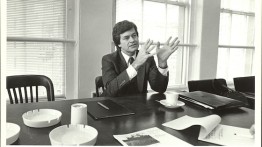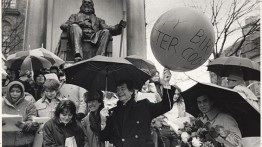In Memoriam: Bill N. Lacy, Former President of The Cooper Union
POSTED ON: August 31, 2020
The Cooper Union’s ninth president, Bill N. Lacy, passed away on August 25.
During Mr. Lacy’s tenure as Cooper’s president from 1980–87, the college celebrated its 125th anniversary, mounted multiple exhibitions, including “Rauschenberg/Performance,” and greatly expanded its free, public programming in the Great Hall. From the start of his presidency, he helped revive music on the Great Hall stage, beginning with the Brooklyn Philharmonic performing at his inauguration and culminating with a residency of the American Jazz Orchestra.
Under his leadership, the school established the Herb Lubalin Study Center of Design and Typography, one of the nation’s first graphic design archives.
“Bill Lacy took deep pride in Cooper Union's legacy and contribution to design and architecture. He was instrumental to founding the Herb Lubalin Study Center, which continues to flourish today,” recalled Ellen Lupton A’85, senior curator at the Smithsonian’s Cooper-Hewitt Museum and Lubalin’s first director.
A native of Oklahoma, Mr. Lacy dreamt of being a professional basketball player before training as an architect at Oklahoma State University. He practiced architecture throughout his career, eventually working for illustrious clients such as the Kimball Art Museum, the J. Paul Getty Trust, Harvard University, and many others. Early on his dedication to architectural education became clear: he worked as an assistant dean at Rice University in the mid-1960s and from 1965–69 he served as the first dean of the new architecture department at the University of Tennessee. Before coming to Cooper, he had been president of the American Academy at Rome (1977–80), and later of SUNY-Purchase (1992–2002).
Mr. Lacy’s influence was far-reaching: he had been director of Architecture and Design at the National Endowment for the Arts, spearheading an initiative to improve the design quality of courthouses and border crossings. As executive director of the Pritzker Architecture Prize from 1988–2005, he oversaw the award’s increased prominence both within and outside the design community.
Dean Nader Tehrani of The Irwin S. Chanin School of Architecture said that President Lacy was instrumental in helping counter corporate forces that were subsuming architecture. Dean Tehrani noted, “In an age when design in the public realm was on the decline, Bill Lacy championed many architectural causes, and his central voice on key cultural committees, among them the Pritzker Awards Jury, served to give rise to critical voices of that era.”






